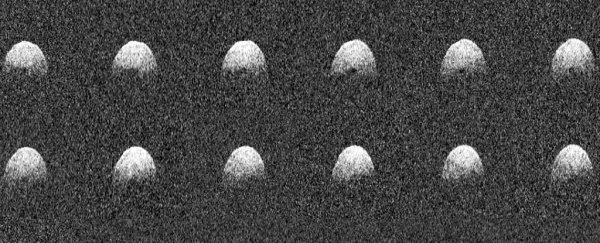New imagery suggests the near-Earth asteroid 3200 Phaethon is bigger than previously thought – and considering it's ranked as the second largest of the asteroids potentially hazardous to our planet, that's worth noting.
Don't run for cover just yet though, because we've got a very good lock on where 3200 Phaethon is going. It won't be coming anywhere close to hitting us for at least 400 years.
Still, the new observations from NASA scientists are going to help us understand more about the nature of 3200 Phaethon, and how the impact might play out if we do eventually get on a collision course with this huge ball-shaped chunk of rock.
Fresh measurements were calculated from the Arecibo Observatory Planetary Radar in Puerto Rico, putting the diameter of the asteroid at 5.8 kilometres or 3.6 miles – that's about 1 kilometre or 0.6 miles bigger than experts thought.
"These new observations of Phaethon show it may be similar in shape to asteroid Bennu, the target of NASA's OSIRIS-REx spacecraft, but more than 1,000 Bennus could fit inside of Phaethon," says one of the scientists, Patrick Taylor, from the Universities Space Research Association (USRA) in Maryland.
The new pictures are sufficiently high-resolution to plot 75 metres (or 246 feet) to a single pixel, and they've also revealed a dark, circular feature near one of the asteroid's poles.
That could be a crater or some other depression in the rock which prevents the scanning radar beam from Arecibo from reflecting back to Earth. Another depression in the object has been spotted near the equator.
To qualify as potentially hazardous objects, these kind of space rocks have to achieve a certain level of size – and their orbits have to bring them close enough to Earth, even if there's very little chance of a direct strike in the near future.
In other words, the "potentially" carries as much weight as the "hazardous" – you don't need to panic just yet, especially with an object like 3200 Phaethon, which has stable movements that can be predicted hundreds of years in advance.
These new readings were made possible as 3200 Phaethon passed by Earth in December, getting as near as 10.3 million kilometres (6.4 million miles) this time around. That's about 27 times the distance from Earth to the Moon.
The asteroid, which was discovered in 1983, won't get as close again until 2093.
The Arecibo Observatory is only just coming back online after the devastating impact Hurricane Maria had on Puerto Rico and its people, the strongest hurricane to hit the island in almost a century.
The facility has the most powerful astronomical radar on the planet, perfect for studying the shape, size, and rotation of asteroids, and for working out exactly where they've been and where they're headed to.
"Arecibo is an important global asset, crucial for planetary defence work because of its unique capabilities," says one of the Arecibo team, Joan Schmelz from USRA.
"We have been working diligently to get it back up and running since Hurricane Maria devastated Puerto Rico."
